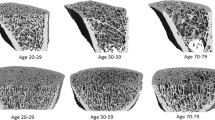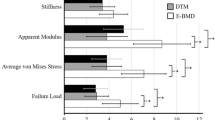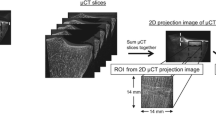Abstract
Osteoporosis leads to bone loss and structural deterioration, which increase the risk of fractures. The aim of this study was to characterize the three-dimensional (3D) bone mass distributions of the distal tibia in normal, osteopenic, and osteoporotic conditions. High-resolution peripheral quantitative computed tomography (HR-pQCT) of the 33 % of the distal tibia and local dual-energy X-ray absorptiometry were applied to 53 intact, fresh-frozen tibiae. The HR-pQCTs were graded to assign local T-scores and merged into three equally sized average normal, osteopenic, and osteoporotic surface models. Volumetric bone mineral density (vBMD) was determined using categorized T-scores, volumetric visualization, and virtual bore probes at the dia-, meta-, and epiphyseal sites (T-DIA, T-META, and T-EPI). We observed a distinct 3D bone mass distribution that was gradually uninfluenced by T-score categories. T-DIA was characterized by the lowest bone mass located in the medullary cavity and a wide homogenous cortex containing the maximum vBMD. The T-META showed decreased cortical thickness and maximal vBMD. At the T-EPI, the relatively low vBMD of the mostly trabecular bone was similar to the maximal cortical vBMD in this sub-region. Four trabecular regions of low bone mass were identified in the recesses. The bone content gradually decreased at all sites, whereas the pattern of bone mass distribution remained essentially unchanged, with the exception of disproportionate losses at T-DIA, T-META, and T-EPI that consistently showed increased endocortical, intracortical, and trabecular bone loss. Extra information can be obtained from the specific pattern of bone mass distribution, potential disproportionate bone losses, and method used.






Similar content being viewed by others
References
Parfitt AM (1996) Skeletal heterogeneity and the purposes of bone remodeling: implications for the understanding of osteoporosis. In: Marcus R, Feldman D, Kelsey J (eds) Osteoporosis. Academic Press, San Diego, pp 315–339
Riggs BL, Melton LJ 3rd, Robb RA, Camp JJ, Atkinson EJ, Peterson JM, Rouleau PA, McCollough CH, Bouxsein ML, Khosla S (2004) Population-based study of age and sex differences in bone volumetric density, size, geometry, and structure at different skeletal sites. J Bone Miner Res 19:1945–1954
Boutroy S, Bouxsein ML, Munoz F, Delmas PD (2005) In vivo assessment of trabecular bone microarchitecture by high-resolution peripheral quantitative computed tomography. J Clin Endocrinol Metab 90:6508–6515
Davis KA, Burghardt AJ, Link TM, Majumdar S (2007) The effects of geometric and threshold definitions on cortical bone metrics assessed by in vivo high-resolution peripheral quantitative computed tomography. Calcif Tissue Int 81:364–371 (Epub 2007 Oct 20)
Melton LJ 3rd, Riggs BL, Keaveny TM, Achenbach SJ, Hoffmann PF, Camp JJ, Rouleau PA, Bouxsein ML, Amin S, Atkinson EJ, Robb RA, Khosla S (2007) Structural determinants of vertebral fracture risk. J Bone Miner Res 22:1885–1992
Mueller TL, Stauber M, Kohler T, Eckstein F, Müller R, van Lenthe GH (2009) Non-invasive bone competence analysis by high-resolution pQCT: an in vitro reproducibility study on structural and mechanical properties at the human radius. Bone 44:364–371. doi:10.1016/j.bone.2008.10.045
WHO Study Group (1994) Assessment of fracture risk and its application to screening for postmenopausal osteoporosis. Report of a WHO Study Group. World Health Organ Tech Rep Ser 843:1–12
Calori GM, Tagliabue L, Mazza E, de Bellis U, Pierannunzii L, Marelli BM, Colombo M, Albisetti W (2010) Tibial pilon fractures: which method of treatment? Injury 41:1183–1190
Ruetsche AG, Kneubuehl R, Birkhaeuser MH, Lippuner K (2005) Cortical and trabecular bone mineral density in transsexuals after long-term cross-sex hormonal treatment: a cross-sectional study. Osteoporos Int 16:791–798
Popp AW, Windolf M, Senn C, Tami A, Richards RG, Brianza S, Schiuma D (2012) Prediction of bone strength at the distal tibia by HR-pQCT and DXA. Bone. doi:10.1016/j.bone.2011.10.033
Kamer L, Noser H, Popp AW, Lenz M, Blauth M (2015) Computational anatomy of the proximal humerus: an ex vivo HR-pQCT study. J Orthop Transl 4:46–56. doi:10.1016/j.jot.2015.09.006
Biver E, Durosier C, Chevalley T, Herrmann FR, Ferrari S, Rizzoli R (2015) Prior ankle fractures in postmenopausal women are associated with low areal bone mineral density and bone microstructure alterations. Osteoporos Int 26:2147–2155. doi:10.1007/s00198-015-3119-9
Popp AW, Senn C, Franta O, Krieg MA, Perrelet R, Lippuner K (2009) Tibial or hip BMD predict clinical fracture risk equally well: results from a prospective study in 700 elderly Swiss women. Osteoporos Int 20:1393–1399. doi:10.1007/s00198-008-0808-7
Casez JP, Troendle A, Lippuner K, Jaeger P (1994) Bone mineral density at distal tibia using dual-energy X-ray absorptiometry in normal women and in patients with vertebral osteoporosis or primary hyperparathyroidism. J Bone Miner Res 9:1851–1857
Bookstein FL (1991/1997) Morphometric tools for landmark data. Cambridge University Press, Cambridge
Noser H, Hammer B, Kamer L (2010) A method for assessing 3D shape variations of fuzzy regions and its application on human bony orbits. J Digit Imaging 23:422–429. doi:10.1007/s10278-010-9287-4
Kamer L, Noser H, Schramm A, Hammer B (2010) Orbital form analysis: problems with design and positioning of precontoured orbital implants: a serial study using post-processed clinical CT data in unaffected orbits. Int J Oral Maxillofac Surg 39:666–672. doi:10.1016/j.ijom.2010.03.005
Meng XL, Rosenthal R, Rubin DB (1992) Comparing correlated correlation coefficients. Psychol Bull 111:172–175
Dryden IL, Mardia KV (1998) Statistical shape analysis. Wiley series in probability and statistics. Wiley, New York
Styner MA, Rajamani KT, Nolte LP, Zsemlye G, Szekely G, Taylor CJ, Davies RH (2003) Evaluation of 3D correspondence methods for model building. Inf Process Med Imaging 18:63–75
Zollikofer CPE, Ponce de León M (2005) Virtual reconstruction, a primer in computer-assisted paleontology and biomedicine. Wiley, New York
Wähnert D, Hoffmeier KL, Lehmann G, Fröber R, Hofmann GO, Mückley T (2009) Temperature influence on DXA measurements: bone mineral density acquisition in frozen and thawed human femora. BMC Musculoskelet Disord 10:25. doi:10.1186/1471-2474-10-25
Szulc P, Seeman E, Duboeuf F, Sornay-Rendu E, Delmas PD (2006) Bone fragility: failure of periosteal apposition to compensate for increased endocortical resorption in postmenopausal women. J Bone Miner Res 21:1856–1863
Zebaze R, Seeman E (2015) Cortical bone: a challenging geography. J Bone Miner Res 30:24–29. doi:10.1002/jbmr.2419
Zebaze RM, Ghasem-Zadeh A, Bohte A, Iuliano-Burns S, Mirams M, Price RI, Mackie EJ, Seeman E (2010) Intracortical remodelling and porosity in the distal radius and post-mortem femurs of women: a cross-sectional study. Lancet 15:1729–1736. doi:10.1016/S0140-6736(10)60320-0
Acknowledgments
We thank Dr. Julian Erggelet for proofreading help. This research project was supported by AOTrauma from the AO Foundation, Davos, Switzerland (Research Grant: Trauma-11-05B).
Author information
Authors and Affiliations
Corresponding author
Ethics declarations
Conflict of Interest
Lukas Kamer, Hansrudi Noser, Michael Blauth, Mark Lenz, Markus Windolf and Albrecht W. Popp declare that they have no conflict of interest.
Ethical Approval
An ethical waiver was provided by the local ethical committee stating that this study did not require an ethical approval.
Rights and permissions
About this article
Cite this article
Kamer, L., Noser, H., Blauth, M. et al. Bone Mass Distribution of the Distal Tibia in Normal, Osteopenic, and Osteoporotic Conditions: An Ex Vivo Assessment Using HR-pQCT, DXA, and Computational Modelling. Calcif Tissue Int 99, 588–597 (2016). https://doi.org/10.1007/s00223-016-0188-5
Received:
Accepted:
Published:
Issue Date:
DOI: https://doi.org/10.1007/s00223-016-0188-5




